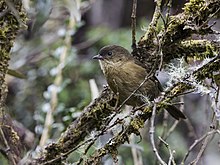| Pardusco | |
|---|---|

| |
| Conservation status | |
 Least Concern (IUCN 3.1) | |
| Scientific classification | |
| Domain: | Eukaryota |
| Kingdom: | Animalia |
| Phylum: | Chordata |
| Class: | Aves |
| Order: | Passeriformes |
| Family: | Thraupidae |
| Genus: | Nephelornis Lowery & Tallman, 1976 |
| Species: | N. oneilli |
| Binomial name | |
| Nephelornis oneilli Lowery & Tallman, 1976 | |

| |
The pardusco (Nephelornis oneilli) is a species of tanager that is endemic to woodland near the timberline in the Andes of central Peru. It is the only member of the genus Nephelornis. This small olive-brown bird is typically seen in groups, which sometimes join mixed species flocks. It has a small range, but is locally fairly common, and consequently considered to be of least concern by BirdLife International and IUCN.
Taxonomy
The pardusco was formally described in 1976 by the American ornithologists George Lowery and Dan Tallman from specimens collected in the Department of Huánuco of central Peru. They introduced the monospecific genus Nephelornis creating the binomial name Nephelornis oneilli. The genus name combines the Ancient Greek nephelē meaning "cloud" with ornis meaning "bird". The specific epithet was chosen to honour the ornithologist John Patton O'Neill. A 2014 molecular phylogenetic study of the tanager family Thraupidae found that the pardusco is a member of the subfamily Poospizinae and has a sister relationship to the black-backed bush tanager in the monospecific genus Urothraupis. The pardusco is monotypic: no subspecies are recognised.
References
- BirdLife International (2017). "Nephelornis oneilli". IUCN Red List of Threatened Species. 2017: e.T22723033A119470418. doi:10.2305/IUCN.UK.2017-3.RLTS.T22723033A119470418.en. Retrieved 11 November 2021.
- Vuilleumier, François; Mayr, Ernst (1987). "New species of birds described from 1976 to 1980". Journal of Ornithology. 128 (2): 137–150. Bibcode:1987JOrni.128..137V. doi:10.1007/BF01661691. ISSN 0021-8375. S2CID 27239055.
- Lowery, George H. Jr.; Tallman, Dan A. (1976). "A new genus and species of nine-primaried oscine of uncertain affinities from Peru". Auk. 93 (3): 415–428.
- Jobling, James A. (2010). The Helm Dictionary of Scientific Bird Names. London: Christopher Helm. pp. 268, 282. ISBN 978-1-4081-2501-4.
- Burns, K.J.; Shultz, A.J.; Title, P.O.; Mason, N.A.; Barker, F.K.; Klicka, J.; Lanyon, S.M.; Lovette, I.J. (2014). "Phylogenetics and diversification of tanagers (Passeriformes: Thraupidae), the largest radiation of Neotropical songbirds". Molecular Phylogenetics and Evolution. 75: 41–77. doi:10.1016/j.ympev.2014.02.006. PMID 24583021.
- Gill, Frank; Donsker, David; Rasmussen, Pamela, eds. (July 2020). "Tanagers and allies". IOC World Bird List Version 10.2. International Ornithologists' Union. Retrieved 6 November 2020.
External links
| Taxon identifiers | |
|---|---|
| Nephelornis oneilli |
|
This article about a tanager is a stub. You can help Misplaced Pages by expanding it. |